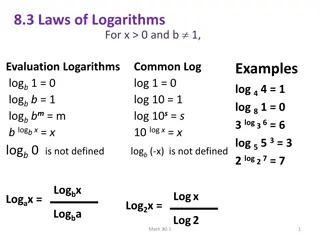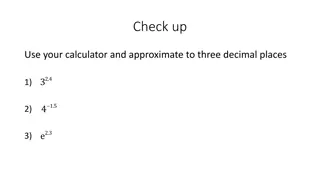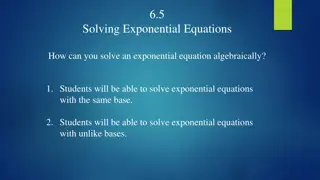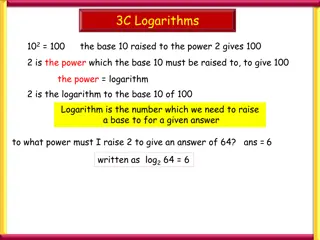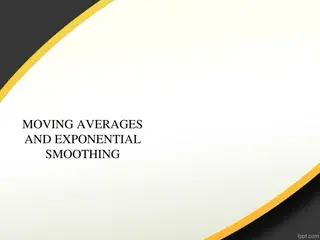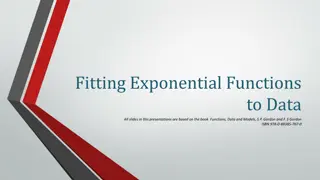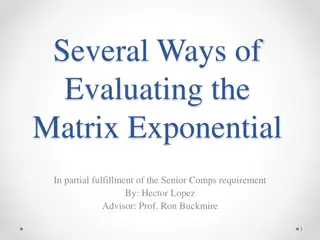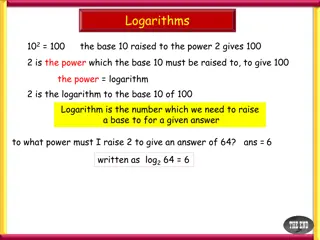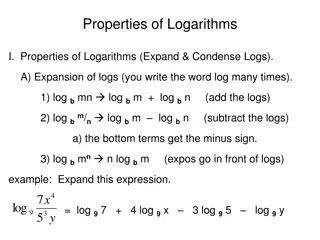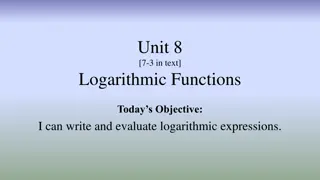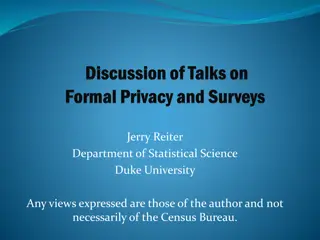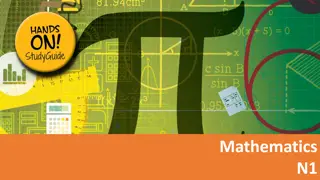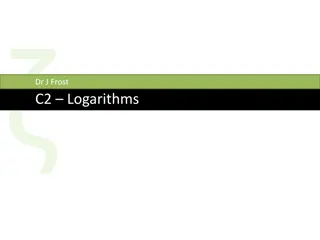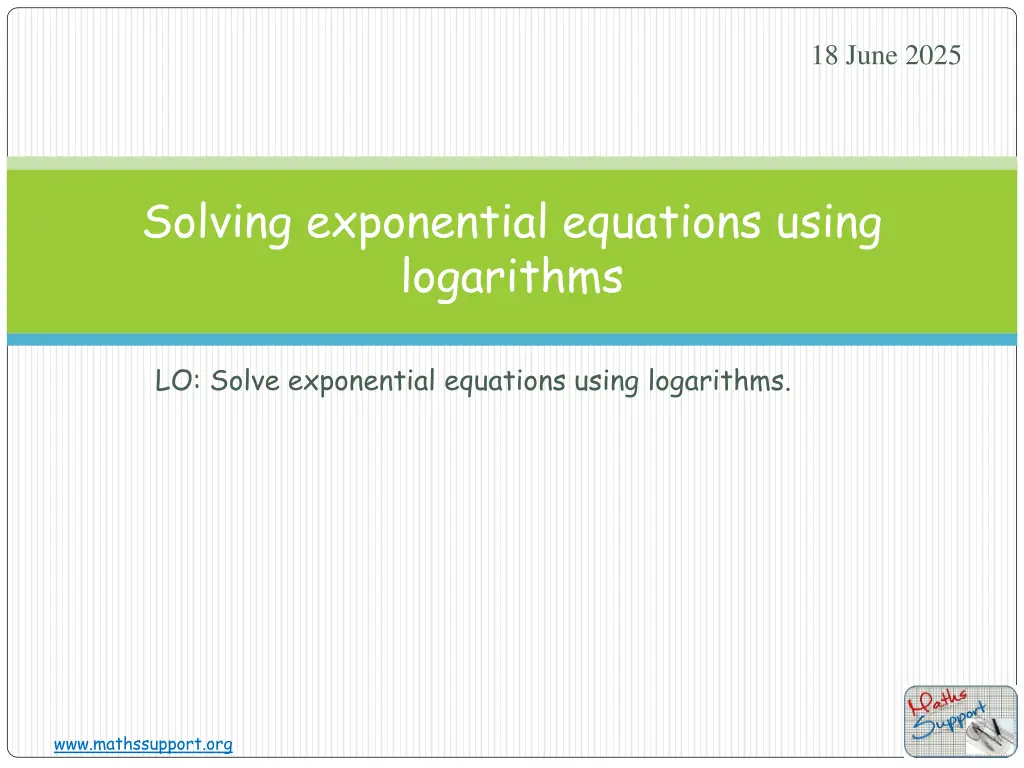
Solving Exponential Equations Using Logarithms - Step-By-Step Guide
Learn how to solve exponential equations using logarithms with detailed examples and visuals. Understand the concept of using logarithms to simplify equations and find precise solutions.
Download Presentation

Please find below an Image/Link to download the presentation.
The content on the website is provided AS IS for your information and personal use only. It may not be sold, licensed, or shared on other websites without obtaining consent from the author. If you encounter any issues during the download, it is possible that the publisher has removed the file from their server.
You are allowed to download the files provided on this website for personal or commercial use, subject to the condition that they are used lawfully. All files are the property of their respective owners.
The content on the website is provided AS IS for your information and personal use only. It may not be sold, licensed, or shared on other websites without obtaining consent from the author.
E N D
Presentation Transcript
18 June 2025 Solving exponential equations using logarithms LO: Solve exponential equations using logarithms. www.mathssupport.org www.mathssupport.org
Exponential Equations Exponential equations are equations involving unknowns as exponents. For example 5x = 25 x = 2 www.mathssupport.org www.mathssupport.org
Exponential Equations One way to solve exponential equations is to use the property that if 2 powers with the same base are equal, then their exponents are equal. if bx = by, then x = y For b > 0 & b 1 Is not always easy to make the bases the same. In this situations we can use logarithms. www.mathssupport.org www.mathssupport.org
Solve using logarithms Solve the equation Example 1 23x = 25 Give the exact answer Taking the logarithm of each side 23x = 25 log 23x = log 25 Using the rule: log bn = n log b 3x log 2 log 2 = log 25 log 2 Dividing by log 2 log 25 log 2 = 3x Dividing by 3 log 25 3 log 2 x = www.mathssupport.org www.mathssupport.org
Solve using logarithms Solve the equation Example 1 23x = 25 Give the answer correct to 3 sf. 23x = 25 Now we will use the GDC to solve it. Turn on the GDC MENUA Equation www.mathssupport.org www.mathssupport.org
Solve using logarithms Solve the equation Example 1 23x = 25 Give the answer correct to 3 sf. 23x = 25 Now we will use the GDC to solve it. Turn on the GDC MENUA Equation F3 Solver www.mathssupport.org www.mathssupport.org
Solve using logarithms Solve the equation Example 1 23x = 25 Give the answer correct to 3 sf. 23x = 25 Now we will use the GDC to solve it. Turn on the GDC MENUA Equation F3 Solver Type in EXE 23x = 25 www.mathssupport.org www.mathssupport.org
Solve using logarithms Solve the equation Example 1 23x = 25 Give the answer correct to 3 sf. 23x = 25 Now we will use the GDC to solve it. Turn on the GDC MENUA Equation F3 Solver Type in EXE 23x = 25 F6 SOLVE www.mathssupport.org www.mathssupport.org
Solve using logarithms Solve the equation Example 1 23x = 25 Give the answer correct to 3 sf. 23x = 25 Now we will use the GDC to solve it. Turn on the GDC MENUA Equation F3 Solver Type in EXE 23x = 25 F6 SOLVE 1.54795206 x = 1.55 The answer for x Rounded to 3sf www.mathssupport.org www.mathssupport.org
Solve using logarithms Solve e3x = 27giving an exact answer. e3x= 27 Takingnatural logs of both sides ln e3x= ln 27 3x= ln 27 Since ln ex = x we cancel lnand e x=ln 27 Dividing by 3 3 Leave your answer in log form since an exact answer is required. www.mathssupport.org www.mathssupport.org
Solve using logarithms ? 2 Solve 2e = 32giving an exact answer. ? 2 2e = 32 e = 16 ? 2 Dividing by 2 Takingnatural logs of both sides ? 2 ln e = ln 16 = ln 16 ? 2 Since ln ex = x we cancel lnand e x= 2 ln 16 Multiplying by 2 Leave your answer in log form since an exact answer is required. www.mathssupport.org www.mathssupport.org
Solving equations of the form ax = b Find the exact points of intersection of y = ex 4 and y = 3 10e xgiving an exact answer. 3 10e x ex 4 The functions meet where = ex 4 - 3 + 10e x = 0 ex 7 + 10e x = 0 e2x 7ex + 10 = 0 (ex 2) (ex 5) = 0 ex = 2 x = ln 2 y = eln 2 4 y = eln 5 4 Equating to 0 Simplifying Multiplying by ex Factorising Solving for x ex = 5 x = ln 5 or or = -2 = 1 When x = ln 2 When x = ln 5 The functions meet at two points (ln 2, -2) (ln 5, 1) and www.mathssupport.org www.mathssupport.org
Solving equations of the form ax = b Find the exact points of intersection of y = ex 4 and y = 3 10e x. Check the solution using technology. (ln 5, 1) and The functions meet at two points (ln 2, -2) Turn on the GDC MENU5 Graph www.mathssupport.org www.mathssupport.org
Solving equations of the form ax = b Find the exact points of intersection of y = ex 4 and y = 3 10e x. Check the solution using technology. (ln 5, 1) and The functions meet at two points (ln 2, -2) Turn on the GDC MENU5 Graph Type in Y1 ex 4 EXE www.mathssupport.org www.mathssupport.org
Solving equations of the form ax = b Find the exact points of intersection of y = ex 4 and y = 3 10e x. Check the solution using technology. (ln 5, 1) and The functions meet at two points (ln 2, -2) Turn on the GDC MENU5 Graph Type in Y1 Type in Y2 ex 4 3 10e x EXE EXE www.mathssupport.org www.mathssupport.org
Solving equations of the form ax = b Find the exact points of intersection of y = ex 4 and y = 3 10e x. Check the solution using technology. (ln 5, 1) and The functions meet at two points (ln 2, -2) Turn on the GDC MENU5 Graph Type in Y1 Type in Y2 F6 Draw ex 4 3 10e x EXE EXE www.mathssupport.org www.mathssupport.org
Solving equations of the form ax = b Find the exact points of intersection of y = ex 4 and y = 3 10e x. Check the solution using technology. (ln 5, 1) and The functions meet at two points (ln 2, -2) Turn on the GDC MENU5 Graph Type in Y1 Type in Y2 F6 Draw F5 G-Solv ex 4 3 10e x EXE EXE www.mathssupport.org www.mathssupport.org
Solving equations of the form ax = b Find the exact points of intersection of y = ex 4 and y = 3 10e x. Check the solution using technology. (ln 5, 1) and The functions meet at two points (ln 2, -2) Turn on the GDC MENU5 Graph Type in Y1 Type in Y2 F6 Draw F5 G-Solv F5 INTSECT ex 4 3 10e x EXE EXE www.mathssupport.org www.mathssupport.org
Solving equations of the form ax = b Find the exact points of intersection of y = ex 4 and y = 3 10e x. Check the solution using technology. (ln 5, 1) and The functions meet at two points (ln 2, -2) Turn on the GDC MENU5 Graph Type in Y1 Type in Y2 F6 Draw F5 G-Solv F5 INTSECT We have the first point (0.693147, -2) ex 4 3 10e x EXE EXE www.mathssupport.org www.mathssupport.org
Solving equations of the form ax = b Find the exact points of intersection of y = ex 4 and y = 3 10e x. Check the solution using technology. (ln 5, 1) and The functions meet at two points (ln 2, -2) Turn on the GDC MENU5 Graph Type in Y1 Type in Y2 F6 Draw F5 G-Solv F5 INTSECT We have the first point (0.693147, -2) The second point (1.60943791, 1) ex 4 3 10e x EXE EXE www.mathssupport.org www.mathssupport.org
Exponential functions in Real life Example 2: The population, P(t), in thousands, of a city is modelled by the function P(t) = 15e( 0.0145)twhere tis the number of years after 1 January 2015. (a) What was the population of the city in 2015? For 2015 t = 0 t is the number of years after 2015. P(0) = 15e ( 0.0145)0 Substitutingt = 0 P(0) = 15e0 P(0) = 15 The population in 2015 was 15 000 www.mathssupport.org www.mathssupport.org
Exponential functions in Real life Example 2: The population, P(t), in thousands, of a city is modelled by the function P(t) = 15e( 0.0145)twhere tis the number of years after 1 January 2015. (b) By what percentage is the population of the city changing each year? t= 1 Calculate the population one year after 2015. P(1) = 15e( 0.0145) 1 15e( 0.0145) Calculate the rate of increase 15 = e( 0.0145) P(0) = 15 Substitutingt = 1 = 0.986 0.986 - 1 = -0.014 100% To calculate percentage change The population is decreasing at the rate of 1.4% each year www.mathssupport.org www.mathssupport.org
Exponential functions in Real life Example 2: The population, P(t), in thousands, of a city is modelled by the function P(t) = 15e( 0.0145)twhere tis the number of years after 1 January 2015. (c) What will the population of the city be on 1 January 2035? t = 20 On 1 January 2035. P(20) = 15e( 0.0145)20 Substitutingt = 20 = 15e 0.29 = 11.22 In 2035 the population will be 11 220 www.mathssupport.org www.mathssupport.org
Exponential functions in Real life Example 2: The population, P(t), in thousands, of a city is modelled by the function P(t) = 15e( 0.0145)twhere tis the number of years after 1 January 2015. (d) When will the city s population be less than 10 000? P(t) = 10 When population is 10 000 Substituting P(t) = 10 10 > 15e( 0.0145)t 2 3> e( 0.0145)t ln2 Divide both sides by 15 3>lne( 0.0145)t ln2 Take logarithms of both sides 3> ( 0.0145)t ln2 0.0145<t Divide both sides by 0.0145 3 t > 27.96 The population will be less than 10 000 in the year 28, that is, during 2043 www.mathssupport.org www.mathssupport.org
Solving equations of the form ax = b We can use logarithms to solve equations of the form ax = b. For example: Find x to 3 significant figures if 52x = 30. We can solve this by taking logs of both sides: log 52x = log 30 2x log 5 = log 30 log 30 =2log 5 x Using a calculator: x = 1.06 (to 3 sig. figs.) www.mathssupport.org www.mathssupport.org
Solving equations of the form ax = b Find x to 3 significant figures if 43x+1 = 7x+2. Taking logs of both sides: x + 3 1 log 4 x (3 +1)log 4 =( + 2)log 7 3 log 4+log 4 = log 7+2log 7 + 2 x =log 7 x x x (3log 4 log 7)= 2log 7 log 4 x 2log 7 log 4 =3log 4 log 7 x x =1.13 (to 3 sig. figs.) www.mathssupport.org www.mathssupport.org
Solving equations of the form ax = b Solve e3x = 51 - xgiving an exact answer. e3x = 51 - x Using natural logs since ln ex = x ln e3x = ln 51 - x 3x = (1 - x) ln 5 3x = ln 5 - x ln 5 3x+ x ln 5 = ln 5 x (3+ ln 5) = ln 5 So, bring down the exponents: Expanding the brackets: Collecting x-terms together: Factorising: ln 5 3+ ln 5 x = Leave your answer in log form since an exact answer is required. www.mathssupport.org www.mathssupport.org
Solving equations of the form ax = b Solve 32x 5(3x) + 4 = 0 to 3 significant figures. If we let y = 3x we can write the equation as: 2 y ( 1)( y =1 or = 4 y So: 3 =1 or 3 = 4 If 3x = 1 then x = 0. Now, solving 3x = 4 by taking logs of both sides: log 3 =log 4 xlog 3 =log 4 5 +4 =0 y 4)=0 y y x x x log 4 =log 3 =1.26 (to 3 sig. figs.) x x www.mathssupport.org www.mathssupport.org
Solving equations involving logarithms We can use the laws of logarithms to solve equations. For example: Solve log5x + 2 = log5 10 To solve this equation we have to write the constant value 2 in logarithmic form: 2 = 2 log5 5 because log5 5 = 1 = log5 52 = log5 25 The equation can now be written as: log5x + log5 25 = log5 10 log5 25x = log5 10 25x = 10 x = 0.4 www.mathssupport.org www.mathssupport.org
Thank you for using resources from A close up of a cage Description automatically generated For more resources visit our website https://www.mathssupport.org If you have a special request, drop us an email info@mathssupport.org www.mathssupport.org www.mathssupport.org





